赛迪顾问-中国文化创意产业地图白皮书
ITIL白皮书
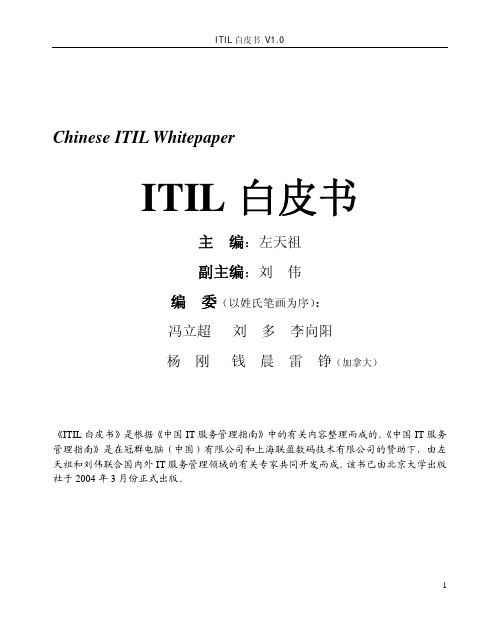
Chinese ITIL WhitepaperITIL白皮书主 编:左天祖副主编:刘 伟编 委(以姓氏笔画为序):冯立超 刘 多 李向阳杨 刚 钱 晨 雷 铮(加拿大)《ITIL白皮书》是根据《中国IT服务管理指南》中的有关内容整理而成的。
《中国IT服务管理指南》是在冠群电脑(中国)有限公司和上海联盈数码技术有限公司的赞助下,由左天祖和刘伟联合国内外IT服务管理领域的有关专家共同开发而成。
该书已由北京大学出版社于2004年3月份正式出版。
致谢顾问委员会(以姓氏笔画为序):Dave Bingham,富士通咨询,英国Jan van Bon,Inform-IT,荷兰John Peng,微软公司,美国Peter Bootsma,Quality Research,荷兰叶健,中国惠普有限公司朱赤红,汉道信息技术咨询有限公司朱海林,科索路信息技术有限公司孙强,赛迪顾问段永朝,中国计算机用户报社评审委员会(以姓氏笔画为序):主审:方皑,GE IT Solutions,加拿大评委(以姓氏笔画为序):Annie Xu,ITpreneurs,荷兰王东红,赛迪顾问刘丁,冠群电脑(中国)有限公司迟振,IBM(上海)全球服务部邢健,中国惠普有限公司沈丕豪,华讯网络系统有限公司何景维,华为技术有限公司巫健,和腾软件有限公司陆培炜,翰纬信息技术管理研究咨询中心杨凯程,联盈数码技术有限公司常威,上海信息化培训中心章斌,联盈数码技术有限公司潘九海,沃尔玛(中国)有限公司项目赞助单位(排名不分先后):感谢冠群电脑(中国)有限公司和上海联盈数码技术有限公司为本指南开发提供支持和赞助。
感谢上海联盈数码技术有限公司的杨凯程先生和冠群电脑(中国)有限公司的谢春颖女士为本指南的开发提供支持和帮助。
感谢国际IT服务管理论坛的CEO埃丹·拉维斯先生提供的支持和帮助。
感谢《中国计算机用户》周刊开辟“服务管理”专栏,为指南的开发提供交流平台。
中国文化创意产业的空间分布和地区绩效分析
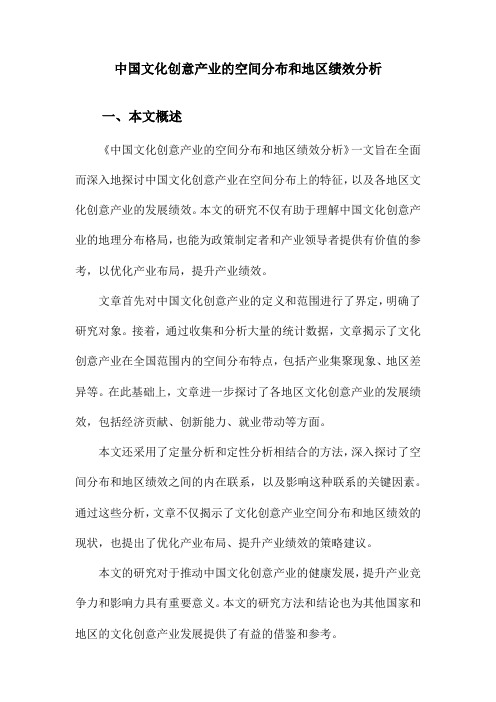
中国文化创意产业的空间分布和地区绩效分析一、本文概述《中国文化创意产业的空间分布和地区绩效分析》一文旨在全面而深入地探讨中国文化创意产业在空间分布上的特征,以及各地区文化创意产业的发展绩效。
本文的研究不仅有助于理解中国文化创意产业的地理分布格局,也能为政策制定者和产业领导者提供有价值的参考,以优化产业布局,提升产业绩效。
文章首先对中国文化创意产业的定义和范围进行了界定,明确了研究对象。
接着,通过收集和分析大量的统计数据,文章揭示了文化创意产业在全国范围内的空间分布特点,包括产业集聚现象、地区差异等。
在此基础上,文章进一步探讨了各地区文化创意产业的发展绩效,包括经济贡献、创新能力、就业带动等方面。
本文还采用了定量分析和定性分析相结合的方法,深入探讨了空间分布和地区绩效之间的内在联系,以及影响这种联系的关键因素。
通过这些分析,文章不仅揭示了文化创意产业空间分布和地区绩效的现状,也提出了优化产业布局、提升产业绩效的策略建议。
本文的研究对于推动中国文化创意产业的健康发展,提升产业竞争力和影响力具有重要意义。
本文的研究方法和结论也为其他国家和地区的文化创意产业发展提供了有益的借鉴和参考。
二、中国文化创意产业概述随着全球化的发展和科技进步的推动,文化创意产业已逐渐成为全球经济发展的新引擎。
中国,作为世界第二大经济体,其文化创意产业的发展同样引人注目。
近年来,中国文化创意产业经历了从无到有、从小到大的快速发展,现已成为推动国家经济转型升级、促进文化软实力提升的重要力量。
中国文化创意产业涵盖了多个领域,包括影视制作、出版发行、音乐创作、美术设计、广告设计、动漫游戏、文化旅游等。
这些领域不仅各自具有深厚的文化底蕴和创意空间,而且相互之间的融合也为产业发展提供了更多可能性。
例如,影视作品可以借助音乐、美术等元素丰富内容,而文化旅游则可以通过影视、动漫等形式进行推广。
在空间分布上,中国文化创意产业呈现出明显的地域性特征。
中国文创园区地图出炉
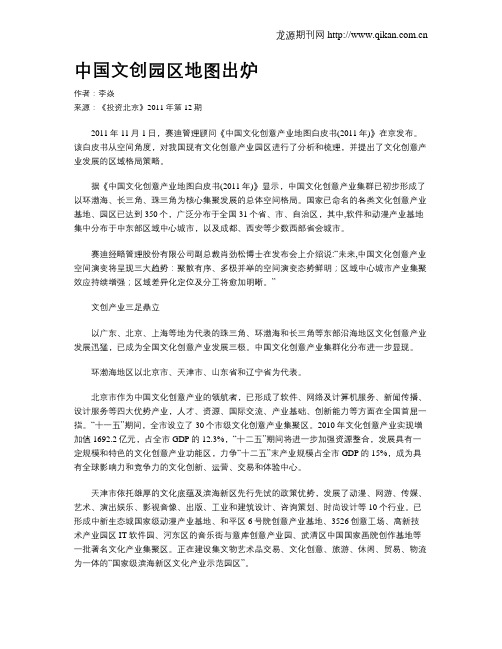
中国文创园区地图出炉作者:李焱来源:《投资北京》2011年第12期2011年11月1日,赛迪管理顾问《中国文化创意产业地图白皮书(2011年)》在京发布。
该白皮书从空间角度,对我国现有文化创意产业园区进行了分析和梳理,并提出了文化创意产业发展的区域格局策略。
据《中国文化创意产业地图白皮书(2011年)》显示,中国文化创意产业集群已初步形成了以环渤海、长三角、珠三角为核心集聚发展的总体空间格局。
国家已命名的各类文化创意产业基地、园区已达到350个,广泛分布于全国31个省、市、自治区,其中,软件和动漫产业基地集中分布于中东部区域中心城市,以及成都、西安等少数西部省会城市。
赛迪经略管理股份有限公司副总裁肖劲松博士在发布会上介绍说:“未来,中国文化创意产业空间演变将呈现三大趋势:聚散有序、多极并举的空间演变态势鲜明;区域中心城市产业集聚效应持续增强;区域差异化定位及分工将愈加明晰。
”文创产业三足鼎立以广东、北京、上海等地为代表的珠三角、环渤海和长三角等东部沿海地区文化创意产业发展迅猛,已成为全国文化创意产业发展三极。
中国文化创意产业集群化分布进一步显现。
环渤海地区以北京市、天津市、山东省和辽宁省为代表。
北京市作为中国文化创意产业的领航者,已形成了软件、网络及计算机服务、新闻传播、设计服务等四大优势产业,人才、资源、国际交流、产业基础、创新能力等方面在全国首屈一指。
“十一五”期间,全市设立了30个市级文化创意产业集聚区。
2010年文化创意产业实现增加值1692.2亿元,占全市GDP的12.3%,“十二五”期间将进一步加强资源整合,发展具有一定规模和特色的文化创意产业功能区,力争“十二五”末产业规模占全市GDP的15%,成为具有全球影响力和竞争力的文化创新、运营、交易和体验中心。
天津市依托雄厚的文化底蕴及滨海新区先行先试的政策优势,发展了动漫、网游、传媒、艺术、演出娱乐、影视音像、出版、工业和建筑设计、咨询策划、时尚设计等10个行业。
2019中国工业遗存再利用路径与典型案例白皮书
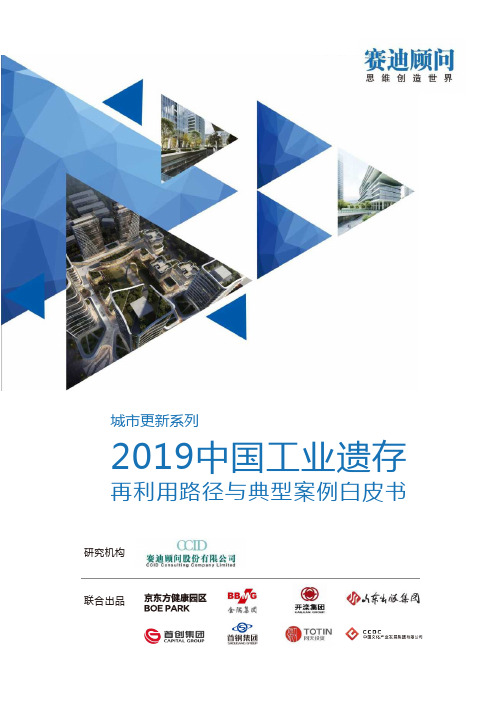
研究机构联合出品2019中国工业遗存再利用路径与典型案例白皮书城市更新系列中国仅用几十年时间完成工业化初期到后期的推进历程,期间也曾出现制造产能向郊区转移、闲置厂房遍布城区的建设难题。
当前,中国经济迈向后工业化时代,城市可持续发展理念深入人心,公众历史保护意识不断增强,曾经承载工业体系发展重任的老旧厂房等工业遗存,正在转变为见证工业历史、传递工业文化、记录城市印记、展现产业变迁、再利用价值可观的“文化富矿”与“特色空间”,是城市更新不可分割的有机组成部分。
本报告由赛迪顾问、京东方健康园区、金隅集团、开滦集团、山东出版集团、首创集团、首钢集团、广东同天投资管理有限公司、中国文化产业发展集团有限公司联合发布。
本报告通过分析中国工业遗存再利用发展现状、展示中国工业遗存再利用典型案例,预判中国工业遗存再利用发展趋势,提出中国工业遗存再利用发展建议,旨在为城市更新的规划与实施提供借鉴,为各地政府、工业企业、地产企业、文创企业,制定工业遗存再利用政策、开展工业遗存再利用合作、设计工业遗存再利用项目提供决策支撑。
第 1 章中国工业遗存再利用背景 01工业遗存基本概念 02中国工业遗存改造发展历程03中国工业遗存再利用发展机遇 04中国工业遗存再利用面临挑战 05 第 2 章中国工业遗存再利用现状 06中国工业遗存空间资源 07中国工业遗存改造方向 08中国工业遗存改造模式 09 第 3 章中国工业遗存再利用案例 10 工业旅游:开滦国家矿山公园 11现代设计:济南国际创新设计产业园 12都市产业:首钢冬奥广场 13文化金融:新华1949文化金融与创新产业园 14智能制造:金隅智造工场 15文化创意:郎园vintage 16总部基地:恒通国际商务园 17 第 4 章中国工业遗存再利用趋势 18 发展趋势 19赛迪建议 20中国工业遗存再利用背景中国工业遗存保护与再利用事业历经30年发展,在政府管理政策不断完善与新兴产业蓬勃发展的双重助力下,正在步入保护与再利用并举的“春天”。
文化创意产业技术白皮书文化创意产业发展知识产权保护和数字文化创新
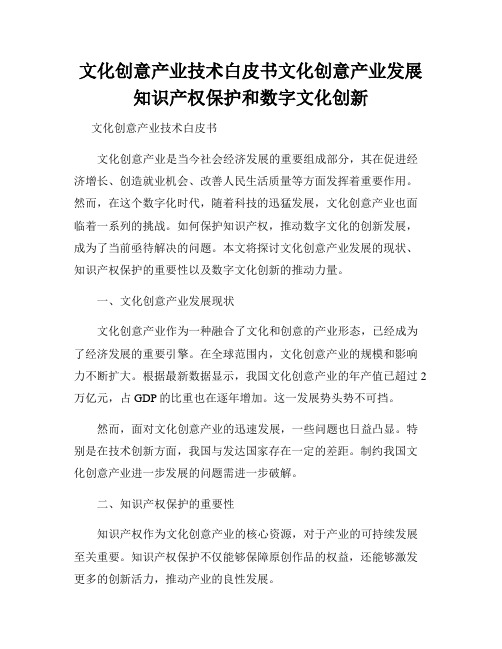
文化创意产业技术白皮书文化创意产业发展知识产权保护和数字文化创新文化创意产业技术白皮书文化创意产业是当今社会经济发展的重要组成部分,其在促进经济增长、创造就业机会、改善人民生活质量等方面发挥着重要作用。
然而,在这个数字化时代,随着科技的迅猛发展,文化创意产业也面临着一系列的挑战。
如何保护知识产权,推动数字文化的创新发展,成为了当前亟待解决的问题。
本文将探讨文化创意产业发展的现状、知识产权保护的重要性以及数字文化创新的推动力量。
一、文化创意产业发展现状文化创意产业作为一种融合了文化和创意的产业形态,已经成为了经济发展的重要引擎。
在全球范围内,文化创意产业的规模和影响力不断扩大。
根据最新数据显示,我国文化创意产业的年产值已超过2万亿元,占GDP的比重也在逐年增加。
这一发展势头势不可挡。
然而,面对文化创意产业的迅速发展,一些问题也日益凸显。
特别是在技术创新方面,我国与发达国家存在一定的差距。
制约我国文化创意产业进一步发展的问题需进一步破解。
二、知识产权保护的重要性知识产权作为文化创意产业的核心资源,对于产业的可持续发展至关重要。
知识产权保护不仅能够保障原创作品的权益,还能够激发更多的创新活力,推动产业的良性发展。
目前,我国已经建立了比较完善的知识产权保护体系,包括专利、商标、版权等各类知识产权的保护机制。
然而,对于文化创意产业来说,知识产权保护还存在一些问题。
比如盗版问题依然存在,侵权行为时有发生。
这给文化创意产业的健康发展带来了一定的困扰。
为了解决这些问题,我们需要加大知识产权保护的力度,完善相关法律法规,并加强执法力度,加大惩处力度。
只有这样,我们才能更好地保护创作者的权益,推动文化创意产业的可持续发展。
三、数字文化创新的推动力量数字化技术的快速普及和发展为文化创意产业的创新提供了新的机遇。
数字化技术具有开放性、互动性、跨界性的特点,能够让文化创意产业更好地融入到数字时代的发展潮流中。
在数字化时代,文化创意产业的创新不再局限于传统的内容创作,而是通过数字技术的应用,开启了全新的创意空间。
中国文创园区地图出炉
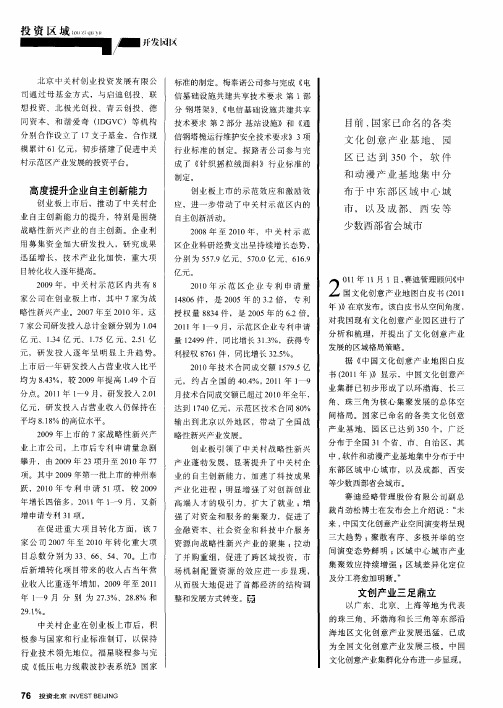
利授权 8 6 件 ,同比增长 3 .%。 71 25 21 0 0年技术 合 同成 交额 1 7 . 5 95亿 元 ,约 占 全 国 的 4 .%,2 1 年 1 0 4 01 —9 月技术合 同成交额 已超过 2 l 年全年 , 00 达 到 14 7 0亿元 ,示 范区技 术合 同 8 % 0 输 出到 北京 以 外地 区,带动 了全 国 战 略性新兴产业发展。 创 业 板引 领 了 中关村 战略性 新 兴
制定 。
高度提升企 业 自主创新 能力
创 业板 上市 后 ,推动 了 中关村 企 业 自主创 新 能力 的提升 ,特 别是 围绕
创 业 板上 市 的示范 效应 和激 励 效 应 ,进 一 步带 动 了 中关村示 范 区 内的
布 于 中 东部 区 域 中心 城
市 , 以及 成 都 、两 安 等 少数西部省会城 市
自主创新活动。
20 0 8年 至 2 1 , 中 关村 示 范 0 0年 区企业 科研经 费支出呈持续增 长态势 , 分 别 为 5 79 元 、5 00亿元 、6 69 5.亿 7. l.
亿元。
战略 性新 兴产 业 的 自Байду номын сангаас 创新 。企业 利
用募 集资 金加 大研 发投 入 ,研 究 成果
量 14 9件 , 同 比增 长 3 _%, 获得 专 29 13
^ 叭 1 1 月 1日, 年 1 赛迪管理顾 问( ( 中 国文化创 意产 业地 图 白皮 书 (0 1 21 年 ) 京发布 。该 白皮书从空 间角度 , 》在
对 我 国现有 文化 创意 产业 园 区进 行 了
分析 和 梳理 ,并提 出 了文化 创意 产业 发展的区域格 局策略。 据 《 中国文 化创 意产 业地 图 白皮 书 (0 1 ) 2 1 年 》显示 , 中国文化创 意产 业集 群 已初 步形 成 了以环 渤海 、长三 角 、珠 三 角为 核心 集 聚发展 的总 体 空 间格 局 。国家 已命 名 的各 类 文化 创意
中国文化创意产业市场竞争力分析
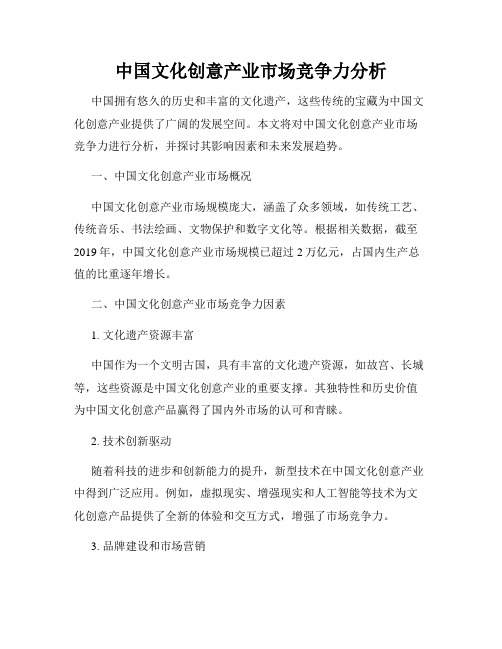
中国文化创意产业市场竞争力分析中国拥有悠久的历史和丰富的文化遗产,这些传统的宝藏为中国文化创意产业提供了广阔的发展空间。
本文将对中国文化创意产业市场竞争力进行分析,并探讨其影响因素和未来发展趋势。
一、中国文化创意产业市场概况中国文化创意产业市场规模庞大,涵盖了众多领域,如传统工艺、传统音乐、书法绘画、文物保护和数字文化等。
根据相关数据,截至2019年,中国文化创意产业市场规模已超过2万亿元,占国内生产总值的比重逐年增长。
二、中国文化创意产业市场竞争力因素1. 文化遗产资源丰富中国作为一个文明古国,具有丰富的文化遗产资源,如故宫、长城等,这些资源是中国文化创意产业的重要支撑。
其独特性和历史价值为中国文化创意产品赢得了国内外市场的认可和青睐。
2. 技术创新驱动随着科技的进步和创新能力的提升,新型技术在中国文化创意产业中得到广泛应用。
例如,虚拟现实、增强现实和人工智能等技术为文化创意产品提供了全新的体验和交互方式,增强了市场竞争力。
3. 品牌建设和市场营销在市场竞争激烈的环境下,品牌建设和市场营销是提升竞争力的关键。
通过打造知名品牌和有效的市场推广策略,中国文化创意产业能够赢得更多的消费者信任和市场份额。
4. 政策支持和产业链完善中国政府对文化创意产业给予了足够的政策支持,以及建设完善的产业链体系。
这不仅为文化创意产业提供了良好的发展环境,还为企业创新和市场扩张提供了资金和政策支持。
三、中国文化创意产业市场竞争力挑战1. 缺乏原创性目前,中国文化创意产业在原创性方面还存在一定的欠缺。
大部分文化创意产品仍然依赖于传统文化元素,并缺乏创新和独特性。
这使得中国文化创意产业在国际市场竞争中面临一定的挑战。
2. 营销策略不足尽管中国在文化创意产业上取得了一定的成就,但仍然缺乏有效的市场营销策略。
许多文化创意产品在推广和宣传方面存在不足,无法充分展示其独特魅力和价值,导致市场影响力不够。
3. 市场监管不完善当前,中国文化创意产业市场的监管机制相对不完善,侵权问题较为突出。
文化创意产业发展战略手册

文化创意产业发展战略手册第一章:文化创意产业概述 (2)1.1 文化创意产业的定义与特征 (2)1.1.1 定义 (2)1.1.2 特征 (2)1.2 文化创意产业的重要性 (3)1.2.1 推动经济增长 (3)1.2.2 传承与创新文化 (3)1.2.3 提升国家形象 (3)1.2.4 促进就业与人才培养 (3)1.2.5 丰富人民精神文化生活 (3)第二章:文化创意产业发展环境分析 (3)2.1 政策法规环境 (3)2.2 市场需求环境 (4)2.3 技术创新环境 (5)第三章:文化创意产业战略规划 (5)3.1 发展目标与战略定位 (5)3.1.1 发展目标 (5)3.1.2 战略定位 (5)3.2 产业布局与区域协同 (6)3.2.1 产业布局 (6)3.2.2 区域协同 (6)3.3 产业链构建与优化 (6)3.3.1 产业链构建 (6)3.3.2 产业链优化 (6)第四章:文化创意产业创新模式 (6)4.1 创新驱动发展战略 (6)4.2 产业技术创新体系 (7)4.3 创新人才队伍建设 (7)第五章:文化创意产业政策支持 (8)5.1 政策体系构建 (8)5.2 财政税收政策 (8)5.3 产业扶持政策 (8)第六章:文化创意产业投融资 (9)6.1 投融资机制创新 (9)6.2 产业基金运作 (9)6.3 风险投资与资本市场 (10)第七章:文化创意产业市场拓展 (10)7.1 市场需求分析 (10)7.2 品牌建设与推广 (11)7.3 跨界融合与市场拓展 (11)第八章:文化创意产业人才培养与引进 (12)8.1 人才培养体系构建 (12)8.2 人才引进政策 (13)8.3 人才激励机制 (13)第九章:文化创意产业服务平台建设 (13)9.1 服务平台类型与功能 (13)9.2 平台运营与管理 (14)9.3 平台发展策略 (15)第十章:文化创意产业区域协同发展 (15)10.1 区域合作模式 (15)10.2 产业链区域布局 (15)10.3 资源整合与共享 (16)第十一章:文化创意产业国际合作与交流 (16)11.1 国际合作策略 (16)11.2 跨国并购与投资 (17)11.3 文化交流与传播 (17)第十二章:文化创意产业案例分析 (18)12.1 成功案例解析 (18)12.1.1 案例一:某知名动漫产业 (18)12.1.2 案例二:某文化科技企业 (18)12.2 问题与挑战 (18)12.2.1 产业链不完善 (18)12.2.2 资金不足 (18)12.2.3 文化输出不足 (19)12.3 发展趋势与启示 (19)12.3.1 跨界融合 (19)12.3.2 数字化转型 (19)12.3.3 人才培养 (19)12.3.4 国际合作 (19)第一章:文化创意产业概述1.1 文化创意产业的定义与特征1.1.1 定义文化创意产业是指在全球化背景下,依托于人类智慧、创造力和文化底蕴,运用现代科技手段,对文化资源进行创造性转化和开发,以文化产品和文化服务为核心,涵盖创意设计、文化艺术、广播影视、出版发行、动漫游戏等多个领域的产业。
文创产业白皮书
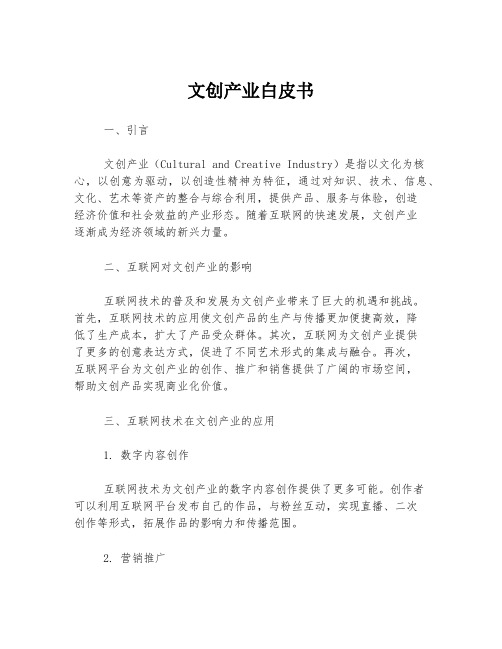
文创产业白皮书一、引言文创产业(Cultural and Creative Industry)是指以文化为核心,以创意为驱动,以创造性精神为特征,通过对知识、技术、信息、文化、艺术等资产的整合与综合利用,提供产品、服务与体验,创造经济价值和社会效益的产业形态。
随着互联网的快速发展,文创产业逐渐成为经济领域的新兴力量。
二、互联网对文创产业的影响互联网技术的普及和发展为文创产业带来了巨大的机遇和挑战。
首先,互联网技术的应用使文创产品的生产与传播更加便捷高效,降低了生产成本,扩大了产品受众群体。
其次,互联网为文创产业提供了更多的创意表达方式,促进了不同艺术形式的集成与融合。
再次,互联网平台为文创产业的创作、推广和销售提供了广阔的市场空间,帮助文创产品实现商业化价值。
三、互联网技术在文创产业的应用1. 数字内容创作互联网技术为文创产业的数字内容创作提供了更多可能。
创作者可以利用互联网平台发布自己的作品,与粉丝互动,实现直播、二次创作等形式,拓展作品的影响力和传播范围。
2. 营销推广互联网平台为文创产业的营销推广提供了非常便捷的途径。
通过社交媒体、搜索引擎、电商平台等渠道,文创产品可以更好地接触到目标用户,提升品牌知名度,扩大市场份额。
3. 跨界合作互联网技术的蓬勃发展促使不同领域间的跨界合作日益增多。
文创产业可以与科技、金融、教育等行业进行合作,实现资源共享和优势互补,促进创新产出。
四、互联网技术带来的挑战与应对策略1. 知识产权保护在互联网时代,文创产品的版权保护成为一项重要任务。
文创产业需要加强知识产权保护意识,探索创新的保护方式,与互联网平台共同合作,建立公平、高效的版权保护机制。
2. 内容质量管理互联网平台上的大量内容使文创产品面临着竞争激烈的局面。
文创产业需要注重内容质量,保持创作独特性与精品化,提供与众不同的产品与服务,树立良好的品牌形象。
3. 技术应用创新互联网技术不断发展,文创产业需要与时俱进,不断创新、更新技术应用,结合新兴技术如人工智能、虚拟现实等,提供更加个性化、沉浸式的用户体验。
2024年中国文化创意产业现状分析报告

摘要:中国文化创意产业在2024年取得了显著的成就,在国内外市场上表现出了强劲的增长势头。
本报告旨在分析2024年中国文化创意产业的现状,包括产业规模、产业结构、发展趋势等方面的情况,并对未来的发展提出建议。
一、产业规模2024年,中国文化创意产业规模持续扩大,实现了较高的增长率。
根据相关数据显示,2024年文化创意产业总产值约为X亿元,比上年增长了X%。
其中,数字内容产业是产值增长最快的板块,达到了X亿元。
二、产业结构2024年中国文化创意产业的产业结构持续优化,新兴产业快速崛起。
传统文化产业仍然是中国文化创意产业的重要组成部分,但数字内容产业、设计创意产业、影视动漫产业等新兴产业的发展势头迅猛。
特别是数字内容产业,得益于移动互联网的普及和消费升级,成为了产业的新“引擎”。
三、发展趋势2024年中国文化创意产业面临着一系列有利因素和挑战因素。
有利因素包括政府支持政策的不断改善、消费升级的推动以及国内市场的扩大。
挑战因素包括国际贸易摩擦的不确定性、产权保护的问题以及人才短缺等。
然而,总体来说,中国文化创意产业有着广阔的发展前景,将继续保持快速发展的态势。
建议:1.加大政策扶持力度。
政府应进一步加大对文化创意产业的扶持力度,提供更多的政策支持、财政支持和税收优惠政策,以推动产业的发展。
2.加强知识产权保护。
加强知识产权保护,建立健全的法律法规体系,加强对文化创意产品和技术的保护,从而提高产业核心竞争力。
3.培养人才。
加大对文化创意人才的培养力度,提供更好的教育和培训机会,培养更多的专业人才,为产业的发展提供支持。
结论:2024年中国文化创意产业在规模、结构和发展趋势上取得了积极的进展。
面对未来,政府、企业和个人需要共同努力,进一步加大对文化创意产业的支持力度,加强知识产权保护和人才培养,以实现产业的可持续发展和繁荣。
赛迪顾问-中国文化创意产业地图白皮书
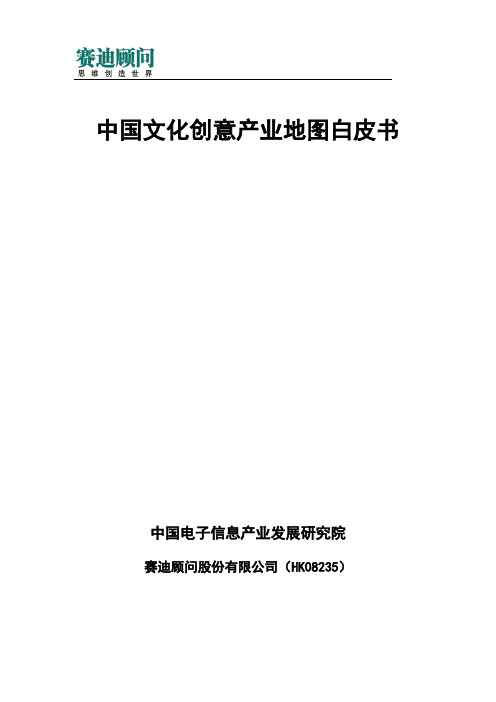
中国文化创意产业地图白皮书中国电子信息产业发展研究院赛迪顾问股份有限公司(HK08235)前言一、研究目的国家“十二五”规划纲要明确指出,推动文化产业成为国民经济支柱性产业,增强文化产业整体实力和竞争力。
实施重大文化产业项目带动战略,加强文化产业基地和区域性特色文化产业群建设;推动文化科技创新,大力发展文化创意、影视制作、出版发行、印刷复制、演艺娱乐、数字内容和动漫等重点文化产业,培育发展新兴文化业态;鼓励文化与资本的对接融合,进一步加快文化体制改革。
因此,中国文化创意产业将迎来加速发展和布局调整的重要机遇。
在“十二五”开局之年,赛迪顾问在总结全球文化创意产业空间分布特点、发展关键要素,分析国内文化创意产业分布特征及资源特征的基础上,对未来中国文化创意产业的空间发展趋势进行了分析,以期为国家和地方的文化创意产业发展与宏观决策提供参考依据。
二、主要结论1、中国文化创意产业集群已初步形成了以环渤海、长三角、珠三角为核心集聚发展的总体空间格局。
2、国家已命名的各类文化创意产业基地、园区已达到350个,广泛分布于全国31个省、市、自治区,软件和动漫产业基地集中分布于中东部区域中心城市,以及成都、西安等少数西部省会城市。
3、未来中国文化创意产业空间演变将呈现三大趋势:(1)“聚散有序,多极并举”的空间演变态势鲜明。
文化创意产业由高等级城市向周边扩散和转移,全国各地文化创意产业蓬勃兴起。
1(2)区域中心城市产业集聚效应持续增强。
区域中心城市在人才、资金、技术获取以及文化消费主体和空间等方面优势明显,文化创意产业集聚效应不断增强。
(3)区域差异化定位及分工将愈加明晰。
东部沿海地区和中西部的区域中心城市软件研发、网络出版、动漫游戏、新媒体等新兴文化产业成长快速,中小城市和农村地区民间演出、手工艺和民俗旅游等传统文化业态特色突出。
图1 2010年中国文化创意产业地图资料来源:文化部、出版总署、各省年鉴、“十二五”相关规划、赛迪顾问文化创意产业数据库2011,0823第一章 中国文化创意区域布局特征一、已形成东部沿海集聚发展的总体格局中国文化创意产业集群化分布进一步显现,初步形成了以广东、北京、上海等地为代表的珠三角、环渤海和长三角等东部沿海地区全国文化创意产业发展三极。
赛迪顾问-中国集成电路产业地图白皮书

中国集成电路产业地图白皮书中国电子信息产业发展研究院赛迪顾问股份有限公司(HK08235)前言一、研究目的2011年1月,国务院正式发布《国务院关于印发进一步鼓励软件产业和集成电路产业发展若干政策的通知》(国发〔2011〕4号),政策进一步明确了集成电路产业的重要地位,即:“软件产业和集成电路产业是国家战略性新兴产业,是国民经济和社会信息化的重要基础”。
未来中国集成电路产业将迎来加速发展和布局调整的重要机遇。
在“十二五”开局之年,赛迪顾问在总结国际集成电路产业分布特点、发展成功模式,分析国内集成电路产业分布特征及资源特征的基础上,对中国集成电路产业未来的空间发展趋势进行了分析,为国家和地方的集成电路产业空间布局与宏观决策提供参考。
二、主要结论1、中国集成电路产业集群已初步形成以长三角、环渤海,珠三角三大区域集聚发展的总体产业空间格局。
2、中国集成电路产业重点城市的分布,则呈现“一轴一带”的特征,即产业集中位于东起上海、西至成都的集成电路产业“沿江发展轴”,以及自北起大连,南至珠海的集成电路产业“沿海产业带”。
3、未来中国集成电路产业空间演变将呈现出四大趋势:(1)产业整体将呈现“有聚有分,东进西移”的演变趋势。
产业区域分布将更加集聚,企业区域投资则趋于分散;设计业将向东部汇聚,制造业将向西部转移。
(2)集成电路设计业将进一步向产学结合紧密的区域汇聚。
以2上海为中心的长三角地区以及以北京为中心的京津地区在集成电路设计领域的优势地位将更加突出。
(3)芯片制造业将向资本充裕的地区延展。
大连、无锡、苏州等沿海地区二线城市将是芯片生产线建设项目的重点。
(4)封装测试业将继续向低成本地区转移。
武汉、合肥等交通便利的中部地区中心城市将是承接转移的重点。
图1 2010年中国集成电路产业地图数据来源:统计局工信部中国半导体行业协会赛迪顾问整理 2011,043第一章中国集成电路产业区域分布特征一、已形成三大区域集聚发展的总体分布格局从2010年中国各省集成电路产值分布图可以看出,目前,中国集成电路产业集群化分布进一步显现,已初步形成以长三角、环渤海,珠三角三大核心区域聚集发展的产业空间格局。
《中国物联网产业地图白皮书》在京发布

《中国物联网产业地图白皮书》在京发布
佚名
【期刊名称】《科技与生活》
【年(卷),期】2011(000)020
【摘要】作为中国工业和信息化部电子信息发展研究院直属研究机构,赛迪顾问10月19日正式发布了《中国物联网产业地图白皮书(2011年)》。
【总页数】1页(P3-3)
【正文语种】中文
【中图分类】F424
【相关文献】
1.赛迪顾问战略性新兴产业之移动互联网与卫星应用产业地图白皮书在京发布 [J],
2.赛迪顾问新能源产业地图白皮书在京发布 [J],
3.赛迪顾问物联网产业地图白皮书与中国集团企业信息化战略研究在京发布 [J],
4.赛迪顾问《中国文化创意产业地图白皮书》在京发布 [J],
5.赛迪顾问《物联网产业地图白皮书》与《中国集团企业信息化战略研究涟京发布[J], 韩霜
因版权原因,仅展示原文概要,查看原文内容请购买。
物联网发展趋势文献检索 王春磊

物联网发展趋势王春磊(昆明学院信息技术学院2011级计算机科学与技术一班邮政编码;650214)摘要: 物联网是新一代信息技术的重要组成部分。
物联网的英文名称叫“The Internet of things”。
顾名思义,物联网就是“物物相连的互联网”。
物联网的定义是:通过射频识别(RFID)、红外感应器、全球定位系统、激光扫描器等信息传感设备,按约定的协议,把任何物体与互联网相连接,进行信息交换和通信,以实现对物体的智能化识别、定位、跟踪、监控和管理的一种网络。
关键词: 计算机科学与技术;物联网;物联网技术与应用;智能技术;传感器。
中图法分类号: TP29文献标识码: 王春磊. 物联网发展趋势[Z].昆明2013.文章编号:The development trend of the Internet of thingsChunlei Wang(Kunming institute of information technology college computer science and technology level 2011 class1 zip code;650214)Abstract: Abstra Internet is an important part of a new generation of information technology.The English name of Internet of things called The Internet of things ".As the name suggests, the Internet of things is connected to the Internet "content".The definition of the Internet of things is: through the radio frequency identification (RFID), infrared sensors, global positioning system (GPS), such as the laser scanner information sensing device, according to the agreement of the agreement, any objects connected to the Internet, information exchange and communication, to achieve the object of the intelligent identification, location, tracking and monitoring and management of a network.Key words: Computer science and technology;The Internet of things;The Internet of things technology and application;Smart technology;Sensors.引言物联网的问世,使得人们将居民区、机场、公路等物理设施与芯片、宽带、智能等技术结合到一起,共同作用与社会管理、经济管理乃至个人生活。
我国文化创意产业竞争格局分析
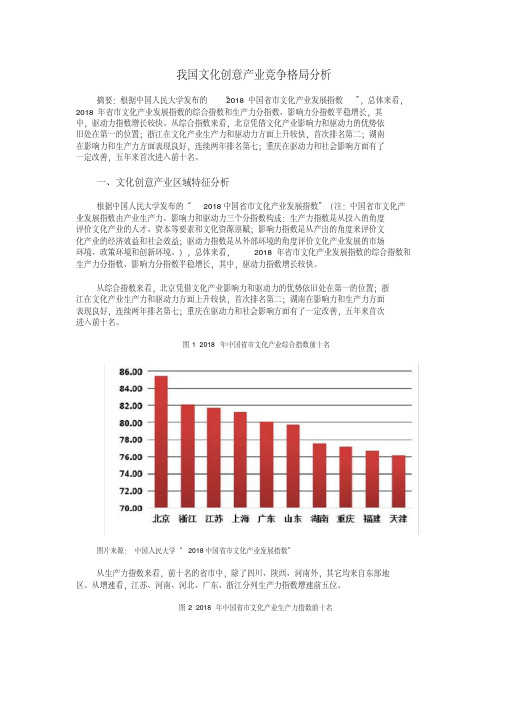
我国文化创意产业竞争格局分析摘要:根据中国人民大学发布的“2018中国省市文化产业发展指数”,总体来看,2018年省市文化产业发展指数的综合指数和生产力分指数、影响力分指数平稳增长,其中,驱动力指数增长较快。
从综合指数来看,北京凭借文化产业影响力和驱动力的优势依旧处在第一的位置;浙江在文化产业生产力和驱动力方面上升较快,首次排名第二;湖南在影响力和生产力方面表现良好,连续两年排名第七;重庆在驱动力和社会影响方面有了一定改善,五年来首次进入前十名。
一、文化创意产业区域特征分析根据中国人民大学发布的“2018中国省市文化产业发展指数”(注:中国省市文化产业发展指数由产业生产力、影响力和驱动力三个分指数构成:生产力指数是从投入的角度评价文化产业的人才、资本等要素和文化资源禀赋;影响力指数是从产出的角度来评价文化产业的经济效益和社会效益;驱动力指数是从外部环境的角度评价文化产业发展的市场环境、政策环境和创新环境。
),总体来看,2018年省市文化产业发展指数的综合指数和生产力分指数、影响力分指数平稳增长,其中,驱动力指数增长较快。
从综合指数来看,北京凭借文化产业影响力和驱动力的优势依旧处在第一的位置;浙江在文化产业生产力和驱动力方面上升较快,首次排名第二;湖南在影响力和生产力方面表现良好,连续两年排名第七;重庆在驱动力和社会影响方面有了一定改善,五年来首次进入前十名。
图1 2018年中国省市文化产业综合指数前十名图片来源:中国人民大学“2018中国省市文化产业发展指数”从生产力指数来看,前十名的省市中,除了四川、陕西、河南外,其它均来自东部地区。
从增速看,江苏、河南、河北、广东、浙江分列生产力指数增速前五位。
图2 2018年中国省市文化产业生产力指数前十名图片来源:中国人民大学“2018中国省市文化产业发展指数”从影响力指数来看,东部地区文化产业经济影响和社会影响优势比较明显,前十名的省市中,有七个来自东部沿海发达地区。
北京文化创意产业发展白皮书(2016)英文版--中国市场经济研究院
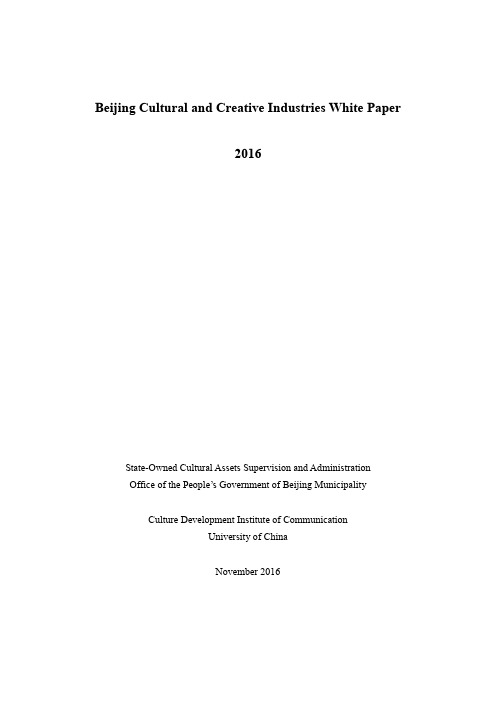
Beijing Cultural and Creative Industries White Paper2016State-Owned Cultural Assets Supervision and AdministrationOffice of the People’s Government of Beijing MunicipalityCulture Development Institute of CommunicationUniversity of ChinaNovember 2016ContentsA. Development Status (2)1. Overall Strength Continues to Increase (2)2. The Industry Develops Steadily (4)3. Capital Markets Are Active (7)B. Industrial Innovation and Development (8)1. The Effective Supply of Culture Is Continuously Expanding (8)2. Cultural and Technological Innovation Trend Is Obvious (10)3. “Cultural and Creative +” Is Effectivel y Promoted (11)4. The Vitality of Cultural Consumption Market Is Strengthened (13)C. Spatial Development Pattern (14)1. Significant Improvement of Agglomeration Effect of Functional Zones .. 152. The Construction of Major Projects in an Orderly Manner (17)3. The initial results of Beijing-Tianjin-Hebei cooperation development (19)D. The Market Players (20)1. The Pace of Reform and Development of State-owned Cultural EnterprisesHave Been Accelerated (20)2. The Non-public Economy and Mass Entrepreneurship and InnovationEnterprise Develop Actively (22)E. Development Environment (24)1. T he P olicy E nvironm e nt H as B een Optimized (24)2. The Investment and Financing Service System of CCI Has Been MoreSound. (26)3. A Series of Service Platform Has Been Constructed. (29)F. Situations and Development Ideas (30)1. Situations and Challenges (30)2. Future Development Ideas (32)The Cultural and Creative industries (CCI) is an important pillar industry in Beijing. Under new circumstances, vigorously developing the Cultural and Creative industries (CCI) is the internal requirements and an important starting point of accelerating the implementation of the strategic positioning of the capital city, promoting the dispersal of non-capital function, constructing the “sophisticated”economic structure and building world-class harmonious livable capital.During 2015, the final year of “the 12th Five-Year Plan”, the Beijing Cultural and Creative industries (CCI) continued to develop well with more stable pillar position, effectively improved quality, better spatial distribution and more complete market system. All these developments further highlighted its role of driving the capital economic growth, promoting the transformation and upgrading, and speeding up the construction of the national cultural center.Going through sustainable, healthy and rapid development during the period of "12th Five-Year Plan", Beijing Cultural and Creative industries (CCI) had been standing on a new historical starting point. The central government promoted the structural reform of the supply side, the public entrepreneurship and innovation, Collaborative Development of Beijing, Tianjin and Hebei Province, “One Belt, One Road” and other major strategies. “Internet +” and “Culture+” were the new circumstances and new environment. Based on the strategic positioning of the capital city in the new period, Beijing Cultural and Creative industries (CCI) adapted to the new normal economic development, ushering in a new strategic opportunity and more broad prospects for development.Beijing Cultural and Creative Industries White Paper (2016) objectively reflects the overall development of Cultural and Creative industries (CCI) in Beijing in 2015. Through the analysis of the new features and new trends of Cultural and Creative industries (CCI), the paper puts forward the goal of development for “the 13th Five-Year plan” and the future development ideas for Beijing Cultural and Creative industries (CCI).A. Development StatusUnder the macro background of strengthening the construction of the national cultural center, alleviating the non-capital function and constructing the "sophisticated" economic structure, Beijing Cultural and Creative industries (CCI) achieved remarkable results in 2015. The industrial scale continued to expand and the contribution to the economy was further enhanced. The proportion of added value, cultural consumption index, foreign trade and other indicators maintained the leading position in the country. The development of the industry made progress while maintaining stability, and the cultural and technological integration had vigorous development. Culture and capital were integrated and further promoted, helping the Cultural and Creative industries (CCI) in good shape.1. Overall Strength Continues to IncreaseIn 2015, Beijing Cultural and Creative industries (CCI) realized an added value of 317.93 billion yuan, accounting for 13.8% of the region’s GDP. It’s 0.6% higher than the previous year. According to the statistics standards of national cultural and related industries, the value added of Beijing cultural and related industries accounted for 8.5% of the region’s GDP, occupying the highest proportion in the country in 2015. The city's Cultural and Creative industries (CCI) totaled 1587.78 billion yuan, a year-on-year increase of 13.6%; the total assets reached 3189.39 billion yuan, a year-on-year increase of 20.6%; employees were 2.023 million, a year-on-year increase of 5.6%. Among them, the revenue of above-scale Cultural and Creative industries (CCI) totaled 1345.13 billion yuan, a year-on-year increase of 14.0%; assets amounted to 2014.02 billion yuan, a year-on-year increase of 20.6%; employees were 1.223 million yuan, a year-on-year increase of 6.2%.In the past five years, Beijing Cultural and Creative industries (CCI) had maintained a relatively fast growth momentum. The industrial added value increased from 169.77 billion yuan in 2010 to 317.93 billion yuan in 2015, an annual growth rate of 13.4 percent at current prices. It’s higher th an a growth rate of 3.1 percentage points of current price of the regional gross domestic products, accounting for the proportion of 13.8% of GDP in 2015 increased from 12.0% in 2010. It had increased by 1.8 percentage points during the five years. The strategic pillar industry status of Culturaland Creative industries (CCI) became more prominent, having more significant pulling effect on the capital economic growth.Investment in fixed assets increased steadily. In 2015, the investment in fixed assets by Beijing Cultural and Creative industries (CCI) totaled 35.3 billion yuan, a year-on-year increase of 9.2%. 110.3% of the annual investment plan of 32.0 billion yuan was completed. The growth and progress were higher than the overall level of the city. Investment focused on the field of industrial integration development, Internet information services, software development and other cultural and technological integration industries. The investment amounted to 12.4 billion yuan, accounting for 35.1% of the total investment. The investment in amusement parks, scenic management and other cultural tourism industries reached 8.7 billion yuan, accounting for 24.6% of the total investment.The potential of cultural consumption sustained release. Beijing cultural consumption index and cultural consumption capacity indicators ranked first. In 2015, the city’s per capita cultural and entertainment consumer spending totaled 2,592 yuan, a year-on-year increase of 11.1% and higher than 2.4 percentage points of total consumption expenditure growth rate. Film, tourism and other cultural markets continued to heat up. the revenue of city's film box office created a record of 3.15 billion yuan, a year-on-year increase of 38.1% and ranking the first in the major cities of the country; The number of audience amounted to 71.642 million, a year-on-year increase of 38.2%. According to the resident population, per capita annual viewing times were up to 3.3 times, ranking the highest in the country. The total number of tourist reception of the city reached 273 million, a year-on-year increase of 4.3%; the total income of tourism reached 460.71 billion yuan, a year-on-year increase of 7.6%. Foreign cultural trade was continuously expanding. As a national cultural center and international communication center, Beijing's foreign trade had been at the forefront of the country all the time. In 2015, Beijing's cultural trade volume increased from US $ 1.265 billion in 2006 to US $ 3.028 billion, with an average annual growth rate of 10.2%. The exports of animation games, book copyrights, and films ranked the forefront of the country. All though the year of 2015, among the national key cultural export enterprises (projects) in Beijing, 70 enterprises and 37 projects were selected. The number accounted for 19.9% and 26.6% respectively of the national total number,ranking the first in China.The enterprise competitiveness had an obvious superiority. The enterprise competitiveness of Beijing cultural and creative enterprises continued to be enhanced, forming a group of leading enterprises with high visibility and influence in the country. In the 7th “Top 30 National Cultural Enterprises” in 2015, 10 Beijing enterprises were shortlisted, including Poly Culture Group Co., Ltd., Beijing Wanda Cultural Industry Group Co., Ltd. and Perfect World (Beijing) Network Technology Co., Ltd. The number accounted for one-third of the country, of which Scenery Culture Co., Ltd.,and Beijing HualuBaina Film & Tv Co.,Ltd., the two Beijing enterprises, were newly selected for the year 2015 annual list.In the situation when overall economy stepped into the new normal, the Beijing Cultural and Creative industries (CCI) were transformed from scale expansion to improved quality and efficiency when the quantitative indicators was still in the growth. These industries paid more attention to enhance the quality and content of development, expand the quality of cultural supply, and transform the force of industrial development. The city's Cultural and Creative industries (CCI) had entered a period of speed-up shift from high-speed growth.2. The Industry Develops SteadilyIn 2015, the development of Cultural and Creative industries (CCI) in Beijing was generally stable, and the leading role of cultural and technological integration was more obvious. At the same time, due to the macroeconomic situation, industrial transformation and upgrading, market adjustment and other factors, the development of various industries showed an uneven trend and the internal structure of the industry were further adjusted.Cultural and technological integration, whose leading role was highlighted, developed powerfully. In 2015, the scale of the software, network and computer service industry, characterized by Cultural and technological integration, was expanding continuously. The annual income of above-scale reached 561.69 billion yuan, a year-on-year increase of 20.4 percent and accounting for 41.8% of the total income of the above-scale enterprises; Total assets amounted to 948.21 billion yuan, a year-on-yearincrease of 28.7% and accounting 47.1% of the city's total assets of the above-scale enterprises; 667,000 employees occupied 54.5% of the total number of employees, a year-on-year increase of 13.1%. The rapid development of cultural and technological integration of industry reflected the "sophisticated" development trend of Cultural and Creative industries (CCI) themselves. Meanwhile, the rapid development further propelled "two-wheel drive" strategy for cultural and technological innovation, promoting economic transformation and upgrading of the capital to lay a good foundation.Four major industries, including advertising and exhibition, tourism and entertainment, radio and television movies, and other ancillary services developed robustly, which served as a strong support for the development of Beijing Cultural and Creative industries (CCI).In 2015, above-scale income of Beijing advertising and exhibition industry reached 158.13 billion yuan, a year-on-year increase of 19.2%; total assets amounted to 130.87 billion yuan, a year-on-year increase of 28.6%; employees were 67,000, down 2.8% year on year. The full application of high-tech promoted the integration and development of advertising and exhibition industry and science and technology, which were important driving forces for industrial transformation and upgrading. In 2015, above-scale income of Beijing tourism and leisure and entertainment industry was 114.02 billion yuan, a year-on-year increase of 15.1%; total assets amounted to 129.75 billion yuan, a year-on-year increase of 18.1%; employees were 92,000, an increase of 2.1% than the previous year. With the function dispersal of non-capital and the contentiously increased efforts for protection of ancient capital style and tourism resources in-depth development, Beijing furthered to highlight its charm as “World Tourism City”.In 2015, the above-scale income of Beijing’s other auxiliary service industry reached 181.19 billion yuan, a year-on-year increase of 24.1%; total assets amounted to 162.13 billion yuan, up 13.3% year on year; employees were 91,000, down 1.0% year on year. Although a slight decline in employees, the revenue and asset growth were maintained at a faster rate.In 2015, the above-scale income of Beijing radio and television film industry totaled 83.0 billion yuan, a year-on-year increase of 5.4%; total assets amounted to 246.73 billion yuan, a year-on-year increase of 17.6%; the number of employees reached 52,000, an increase of 1.1% than the previous year. In recent years,the industry had maintained steady growth, but the growth rate slowed down because of the impact of new media, such as the Internet and mobile Internet.The four industries, including news publishing, art trading, design services and culture and arts, were faced with great growth pressure and stepped into the period of market adjustment.In 2015, the above-scale income of Beijing press and publication industry reached 84.79 billion yuan, down 0.8% year on year; total assets amounted to 175.82 billion yuan, a year-on-year increase of 8.3%; the number of employees 10.3 million, down 2.3% year on year. Under the impact of the rapid development of new media, It was extremely urgent for the traditional press and publishing industry to promote the digital transformation and upgrading and cross-industry integration development.In 2015, the turnover of the Beijing artwork industry was 95.51 billion yuan, down 6.9% year on year; the total assets amounted to 81.95 billion yuan, a year-on-year increase of 8.5%; employees reached 1,3000, down 9.6% year on year. Under the impact of art market heat reduction, price overdraft and other factors in recent years, industry income and employees were on the decline. Now they entered a rational return period and the market adjustment period and the downward pressure would further increase.In 2015, the above-scale income of Beijing design service industry was 42.81 billion yuan, down 4.1% year on year; total assets amounted to 77.31 billion yuan, a year-on-year increase of 6.8%; employees were 98,000, down 1.2% year on year. Influenced by the real estate investment, real estate sales decline and other factors, the industry market was correspondingly narrowed. Layoffs and savings appeared in large and medium-sized design enterprises; the survival pressure of small business increased and industry revenue and employees decreased.In addition, the above-scale income of Beijing arts and cultural industry totaled 24.0 billion yuan, down 2.2% year on year. The number of employees was 41,000, down 1.4% year on year; the industry's total income reached 42.18 billion yuan, a year-on-year increase of 2.9%; the employees of the industry amounted to 126,000, a year-on-year increase of 12.7%. In the premise of the decline of above-scale income and employees, the active degree and contribution rate of small micro-enterprises and individual employees was on continuous increase.3. Capital Markets Are ActiveCulture and capital were integrated in depth, which was an important support and motivation to boost the development of Cultural and Creative industries (CCI) and also the important manifestation of the growth and improved quality and efficiency of the industries. As a national cultural center, Beijing owns rich resources in film and television, the media and the Internet. The policy environment had been improved day by day. Cultural and Creative industries (CCI) had a good momentum of development. Culture and capital were integrated deeply, helping the rapid development of the industry. These altogether became a significant trend of the Beijing Cultural and Creative industries (CCI) in 2015. According to incomplete statistics, the capital market of Beijing Cultural and Creative industries (CCI) was active in 2015, a number of data indicators far more than other regions in the country in a leading position.Equity financing: in 2015, the equity financing of Beijing Cultural and Creative industries (CCI) was 50.156 billion yuan, a year-on-year increase of 50.3%. The capital scale and the number of cases relevant to equity financing ranked the first in the country. “Internet + culture” was a hot spot for equity financing.Merger and acquisition (M & A): in 2015, the mergers and acquisitions of Beijing Cultural and Creative industries (CCI) reached 86.934 billion yuan, a year-on-year increase of 125.2%. The number of mergers and acquisitions increased to 66 cases from 55 in 2014. In 2015, in the wave of mergers and acquisitions among Cultural and Creative industries (CCI), Beijing Wanda Cultural Industry Group developed a school of its own, as it acquired Australia's second largest cinema line operator, Hoyts, and 18 chain cinemas subordinated to Shimao Group.Listing situation:In 2015, six new cultural and creative enterprises were listed in Beijing. Financing scale of a total of 62 listed companies reached 51.826 billion yuan. The number of listed companies and financing scale maintained the leading position in the domestic market; listed companies were mainly distributed in 31 culture and information transmission services, 11 cultural creativity and design services, as well as 6 radio and television film service industry. The financing scale of each industry was 26.667 billion yuan, 9.593 billion yuan and 3.921 billion yuan respectively. In 2015, there were 99 “new three board” listed cultural and creative enterprises in Beijing, accounting for 27.27% (the highest) of the total number of national “new three board” cultural enterprises.Crowd funding: in 2015, there were a total of 487 Crowdfundings of Cultural and Creative industries (CCI) in Beijing. 284 million yuan was raised, a year-on-year increase of 855.2%. The number of cases and the amount of raised funds ranked the first in the country.B. Industrial Innovation and DevelopmentIn 2015, the Beijing Cultural and Creative industries (CCI) made efforts to create new supplies, converse new impetus, develop new models, and expand new demands. Industrial innovation and development was actively promoted; effective supply of cultural products continued to be expanded; science and technology innovation played a more prominent role in industrial development; the integration and development of industries was significantly enhanced; the potential cultural consumption was further released; new types of cultural consumption, such as online consumption and cross-regional linkage consumption, were rapidly developed.1. The Effective Supply of Culture Is Continuously ExpandingAt present, Cultural and Creative industries (CCI) developed rapidly. However, as the supply of cultural products continued to be enriched, the supplies of low-end and homogeneous products were exceeded. The supplies of high-end, characteristic and boutique cultural products were inadequate to meet the growing cultural needs of residents. Under the new circumstance of high-quality, personalized and diversifiedcultural consumption, the development of Beijing Cultural and Creative industries (CCI) focused on the supply side, vigorously improved the quality of cultural products and services, and launched a number of cultural boutiques with Beijing characteristics and the capital standard.Build activities platform and promote cultural quality creation. In 2015, collection assessment work for “the 2015 Beijing Key Projects of Cultural Quality Engineering” was held twice, covering a total of six categories of 57 selected projects. There were a series of cultural activities for the people of the capital, such as "Dancing Beijing" and "Artistic Beijing". The activities fully inspired the public to participate in the culture, enjoy the culture and create the culture vigorously and vitally.Guide the industry focus and improve the quality of cultural products. Film industry had an eye-catching performance in 2015. Beijing produced 291 films, accounting for 42% of the national total; in the top 20 domestic films at the box office, Beijing produced 13, accounting for 65%; Among the 5 domestic films, whose box office was more than 1 billion, Beijing produced four. Anti-Japanese war movie the Hundred Regiments Offensive made 420 million yuan at the box office, which brought the movie social benefits and excellent economic efficiency. The war-themed TV drama Surge, played on Beijing TV, had the highest audience rating among the same kind of TV dramas. And the network click broke through 300 million times. Beijing Cultural and Creative Industry Investment Fund Management Co., Ltd. participated in the cast of the TV series the Ordinary World, which had good ratings and reputation and accessed to “Flying Goddess Award” for outstanding TV awards and many other awards. The quality of animation films was enhanced obviously. The box office of Monkey King: here is back and Monster Hunt amounted to nearly 3.4 billion yuan. In addition to achieving good social and economic benefits, the quality of the creation was on increase at the same time. New modes of operation, such as “Crowdfunding” and “Water Marketing”, were opened up, highlighting the industrial quality precursor and narrowing the gap with the international advanced level.In the field of press and publication, there were 12,630 kinds of books published in 2015. Six books, including War Revelation, were selected for the key books in 70th anniversary of Victory of the Anti-Japanese War. 109 kinds of themed publications,such as Peking Anti-Japanese War Record,and 36 kinds of electronic publications, such as Red Letter, were selected as recommended directory of National Press and Publication. The main themed books were brought into the mainstream market in Europe and America and new breakthroughs were achieved. The English version of Chinese Dream had become the largest Chinese copyright books in the United States in recent years.As for cultural performances, 24,238 performances were held in the ci ty’s 135 commercial performance venues throughout the year of 2015, attracting 10.36 million audiences. The performance income reached 1.55 billion yuan, up 4% over the previous year. Beijing Opera Zheng Kaofu and Qiu Shengrong, Kunqu Opera Li Qingzhao and Confucius into the Wei Ming, and Hebei Clapper Opera Zhang Juzheng were listed as the Beijing cultural projects.2. Cultural and Technological Innovation Trend Is ObviousScientific and technological innovation is a powerful engine and internal driving force to promote the development of Cultural and Creative industries (CCI). It also provides strong support for the change, development, quality and efficiency of Cultural and Creative industries (CCI). In 2015, under the guidance of the State Council's Directive on Actively Propelling the Internet + Action and the Action Plan for Promoting the Development of the Big Data, Beijing Cultural and Creative industries (CCI) and technology integration development were further promoted; the Internet +, Big data, virtual reality technology had been widely used. Scientific and technological innovation promoted Cultural and Creative industries (CCI) to flourish.In 2015, Beijing's software, network and computer services industry developed strongly. the industry's total revenue accounted for 40.6% of the city's cultural and creative industry's total revenue;the industry's total assets accounted for 43.0% of the total assets of the city's Cultural and Creative industries (CCI);industry employees accounted for 50.1% of the city’s total employees of Cultural and Creative industries (CCI). All these fully embodied the integration of cultural and technological industry, especially the "Internet + Culture" development of the dominant trend.The commercial activities of emerging cultural and technological integration had a rapid development. In 2015, a number of commercial activities of emerging cultural integration, including digital new media, animation and games and digital publishing developed soundly. Animation and game industry in particular developed well. In 2015, the output value of animation games in Beijing reached 45.5 billion yuan, accounting for one third of the country's total output value. The datum was up 22.3 percent from 37.2 billion yuan in 2014, 250 percent higher than the growth of 13 bill ion yuan in the early period of the “12th Five-Year Plan”. Exports reached 5.87 billion yuan, ranking the first in the country. Compared with 4.2 billion yuan in 2014, exports had increased by 39.7%; compared with 1.2 billion yuan in 2011 (the early year o f “12th Five-Year Plan”, it achieved a growth of 389%. Especially innovative games, represented by mobile games, developed rapidly. In 2015, the output value of the city's mobile game enterprises reached 28.76 billion yuan, accounting for 65% of the output value of national mobile games. In the field of animation games, Beijing has formed an integrated industrial chain of creation, research and development, publication, operation and distribution, which made Beijing the center of the national cartoon game industry.Cultural and technological integration helped to boost the innovation of business model. Cultural and technological innovation not only led the rapid development of Cultural and Creative industries (CCI), but also gave birth to business model innovation in the field of Cultural and Creative industries (CCI). New business models, including “IP”, chain operation of digital publishing industry, and precision marketing of big data continued to emerge, providing an important support for the innovation and development of Beijing Cultural and Creative industries (CCI).3. “Cultural and Creative +” Is Effectively PromotedIn April 2015, Beijing launched the Action Plan for Promoting the Integration of Cultural Originality and Design Services and Related Industries in Beijing (2015-2020). Based on the objectives of the transformation and upgrading of the capital economy and the construction of “sophisticated” industrial structure, the paper proposed “10 activities of integrative development” of Cultural and Creative industries (CCI) to actively construct “creativity +” economic development mode; to promote cultural creativity and design services to become a powerful impetus foraccumulating and enhancing the energy development of the real economy; to accelerate the transformation and upgrading of related industries.New local standards lead the development of industry integration. In December 2015, Beijing issued Local Standards for Cultural and Creative Industries (CCI) and related Industries. Compared with the old standard of CCI, the new standard absorbed some of the contents of the national cultural industry standard. It would include the industries with strong correlation with the functional orientation in the cities of national cultural center. Thus, industry categories that were focused to be eased in old standard were deleted in the new one, which particularly reflected the new trends of the integrative development of Cultural and Creative industries (CCI) and other industries. The new standard strength ened the concept of “industrial cluster”, emphasizing the deep integration of culture, technology and economy. It covered not only the whole content of cultural industry, but also the content of science and technology innovation and investment management. The characteristics of financial and other industries integrative development were well manifested in the new standard.Series of theme activities to promote "cultural and creative +" had substantial advance. In 2015, Beijing International Design Week showcased the innovative achievements of Beijing's cultural creativity and design services and related industries through the theme of “City of Design, Smart City and Industry Convergence”. The “China Design Festival” held in Daxing District, built platform o f innovation and exchange for brand-new design industry. It further promoted the integration of creative design and other areas, such as urban, people's livelihood, and science and technology. In 2015, in the Tenth China Beijing International Cultural and Creative Industry Fair, more than half of the projects were "culture +" emerging commercial activities. “A series of projects, including 40 Scenic Spots Interactive Media of the Summer Palace” and “Wenchuang Inclusive loan” launched by Bank of Beijing, all made good results. In 2015, the “Cooperative promotion event of Beijing Cultural Integrative Development Project” covered culture and technology, digital non-heritage, cartoon games, cultural tourism, online education, culture and sports, etc. The total value of the contracted projects amounted to 1.125 billion yuan.。
赛迪顾问-中国城市文化创意产业发展研究
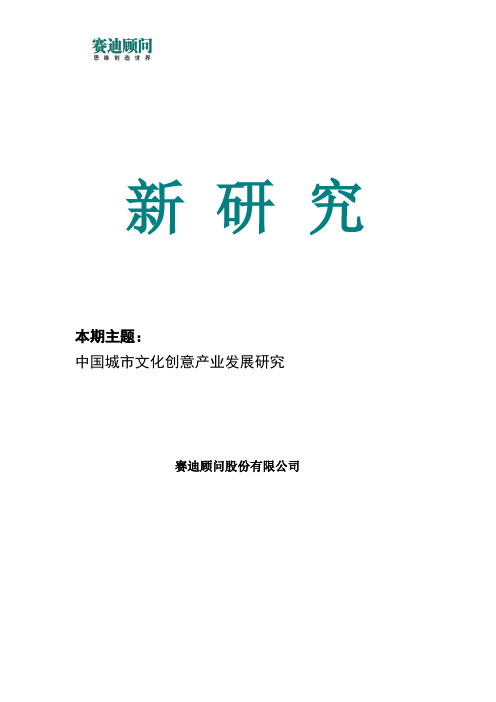
新研究本期主题:中国城市文化创意产业发展研究赛迪顾问股份有限公司本期主题中国城市文化创意产业发展研究第一章中国文化创意产业发展研究1.1 文化创意产业的概念和特征1.1.1 概念和分类创意产业最早出现在英国,1997年英国成立了以布莱尔首相为主席的“创意产业特别工作组”,标志现代创意产业的兴起,从此之后,创意产业概念迅速成为全球热点。
创意产业是一个开放性的、多样化的、动态性的概念。
世界上各个国家和地区,对于创意产业的概念定位、内容涵盖以及相关产业分类等,各有各的特点,各有各的侧重。
互相之间既有共同的认知,也有彰显个性的差异,就连名称也各自带有各自的特色。
英国、新西兰、新加坡等国家,称之为“创意产业”,美国、加拿大、澳大利亚等国家则定名为“版权产业”,一些欧洲国家和中国的台湾省使用的是“文化创意产业”,中国香港特别行政区叫做“创意工业”。
不同的定义源于不同的国家或地区战略、地域特征、文化政策、主导趋向。
表 1 不同国家/地区对创意产业的定义及分类定义国家/地区定义分类创意产业英国源于个人创造力、技能和才华的活动,通过知识产权的生成和利用,使这些活动发挥创造经济效益和就业的产业。
13类:广告、建筑、艺术及古董市场、工艺、设计、流行设计与时尚、电影与录影带、休闲软件与游戏、音乐、表演艺术、出版、软件与电脑服务业、广播电视新西兰没有明确定义9类:广告、软件与资讯服务业、出版、广播电视、建筑、设计、时尚设计、音乐与表演艺术、视觉艺术新加坡创意产业工作小组(CreativeIndustries Working Group)的创意产业发展策略基本上采用英国定义。
3类:艺术与文化(摄影、表演及视觉艺术、艺术品与古董买卖、手工艺品)、设计(软件设计、广告设计、建筑设计、室内设计、平面产品及服装设计)、媒体(出版、广播、数字媒体、电影)版权产业美国美国版权产业系指所有以版权为基础的产业部。
4类:核心版权产业、交叉产业、部分版权产业、边缘支撑产业加拿大没有明确定义出版、广播、电影、电视、图书、杂志、音像等在内的印刷、生产、制作、广告及发行,包括表演艺术、视觉艺术、博物馆、图书馆、3 定义 国家/地区 定义 分类档案馆、书店、文具用品商店等在内的服务,也包括信息网络、多媒体等内容澳大利亚 生产具有创意特性的以数字格式、有知识产权内容的数字内容和信息通讯应用产品,可以分布在网络和非网络媒体。
- 1、下载文档前请自行甄别文档内容的完整性,平台不提供额外的编辑、内容补充、找答案等附加服务。
- 2、"仅部分预览"的文档,不可在线预览部分如存在完整性等问题,可反馈申请退款(可完整预览的文档不适用该条件!)。
- 3、如文档侵犯您的权益,请联系客服反馈,我们会尽快为您处理(人工客服工作时间:9:00-18:30)。
中国文化创意产业地图白皮书中国电子信息产业发展研究院赛迪顾问股份有限公司(HK08235)前言一、研究目的国家“十二五”规划纲要明确指出,推动文化产业成为国民经济支柱性产业,增强文化产业整体实力和竞争力。
实施重大文化产业项目带动战略,加强文化产业基地和区域性特色文化产业群建设;推动文化科技创新,大力发展文化创意、影视制作、出版发行、印刷复制、演艺娱乐、数字内容和动漫等重点文化产业,培育发展新兴文化业态;鼓励文化与资本的对接融合,进一步加快文化体制改革。
因此,中国文化创意产业将迎来加速发展和布局调整的重要机遇。
在“十二五”开局之年,赛迪顾问在总结全球文化创意产业空间分布特点、发展关键要素,分析国内文化创意产业分布特征及资源特征的基础上,对未来中国文化创意产业的空间发展趋势进行了分析,以期为国家和地方的文化创意产业发展与宏观决策提供参考依据。
二、主要结论1、中国文化创意产业集群已初步形成了以环渤海、长三角、珠三角为核心集聚发展的总体空间格局。
2、国家已命名的各类文化创意产业基地、园区已达到350个,广泛分布于全国31个省、市、自治区,软件和动漫产业基地集中分布于中东部区域中心城市,以及成都、西安等少数西部省会城市。
3、未来中国文化创意产业空间演变将呈现三大趋势:(1)“聚散有序,多极并举”的空间演变态势鲜明。
文化创意产业由高等级城市向周边扩散和转移,全国各地文化创意产业蓬勃兴起。
1(2)区域中心城市产业集聚效应持续增强。
区域中心城市在人才、资金、技术获取以及文化消费主体和空间等方面优势明显,文化创意产业集聚效应不断增强。
(3)区域差异化定位及分工将愈加明晰。
东部沿海地区和中西部的区域中心城市软件研发、网络出版、动漫游戏、新媒体等新兴文化产业成长快速,中小城市和农村地区民间演出、手工艺和民俗旅游等传统文化业态特色突出。
图1 2010年中国文化创意产业地图资料来源:文化部、出版总署、各省年鉴、“十二五”相关规划、赛迪顾问文化创意产业数据库2011,0823第一章 中国文化创意区域布局特征一、已形成东部沿海集聚发展的总体格局中国文化创意产业集群化分布进一步显现,初步形成了以广东、北京、上海等地为代表的珠三角、环渤海和长三角等东部沿海地区全国文化创意产业发展三极。
此外,中部地区湖南、湖北,西部地区的四川、陕西也具备良好的产业基础。
图 2 2010年中国文化创意产业区域分布现状资料来源:文化部、出版总署、各省统计年鉴、赛迪顾问文化创意产业数据库2011,084二、重点区域1、环渤海地区图 3环渤海地区文化创意产业分布概览北京市:中国文化创意产业的领航者。
已形成了软件、网络及计算机服务、新闻传播、设计服务等四大优势行业,人才、资源、国际交流、产业基础、创新能力等方面在全国都首屈一指。
“十一五”期间,全市设立了30个市级文化创意产业集聚区。
2010年文化创意产业实现增加值1692.2亿元,占全市GDP的12.3%,“十二五”期间将进一步加强资源整合、优化,发展具有一定规模和特色的文化创意产业功能区,力争“十二五”末文化创意产业的规模占全市GDP的15%,成为具有全球影响力和竞争力的文化创新、运营、交易和体验中心。
天津市:中西文化汇集交融之地。
依托雄厚的文化底蕴、丰富的历史文化资源以及滨海新区先行先试的政策优势,发展了动漫、网游、传媒、艺术、演出娱乐、影视音像、出版、工业和建筑设计、咨询策划、时尚设计等10个行业。
天津滨海新区的软件、数字内容和动漫、西青区的文化旅游和民俗艺术、和平区的历史文化旅游、南开区的民俗文化游等特色鲜明。
已形成中新生态城国家级动漫产业基地、和平区6号院创意产业基地、3526创意工场、高新技术产业园区IT软件园、河东区的音乐街与意库创意产业园、武清区中国国家画院创作基地等一批著名文化产业集聚区。
正在建设集文物艺术品交易、文化创意、旅游、休闲、贸易、物流为一体的“国家级滨海新区文化产业示范园区”。
山东省:齐鲁文化的发祥地。
具有良好的自然和人文资源,文化旅游业发达,是继广东和北京之后的第三个迈入文化创意产业“千亿元”俱乐部的省份。
青岛的文化旅游、节庆创意和创意设计,济南的软件、动漫和新闻出版,潍坊的风筝,淄博的书画古玩、工艺美术业等独具优势。
已形成曲阜新区文化产业园和英雄山特色文化产业园区、璀璨中华文化生态产业园、中华(博山)陶琉文化城、国贸天成文化创意产业园等一批国家级文化产业示范园区。
辽宁省:全国重要的软件和动漫基地。
其中,大连的软件、动漫、文化会展以及文化旅游产业,沈阳的动漫和演艺娱乐,鞍山和本溪的工艺美术产业等特色显著。
拥有沙河口区星海创意岛(国家级)、沈阳棋盘山开发区(省级)、新民文化博览园等一批重点文化创意产业园区。
华强文化创意产业基地、酷贝拉创意产业园、沈阳123创意产业园等重大项目也正在56规划建设中。
2、长三角地区图 4 长三角文化创意产业分布概览上海市:著名的 “世界设计之都”。
拥有15家文化产业园区和80家创意产业集聚区,已初步形成“一轴(延安高架主轴)、两河(黄浦江、苏州河)”分布格局,包括动漫谷文化创意产业基地、张江文化产业园区、国家数字出版基地、徐汇数字娱乐产业基地、长宁多媒体产业基地、普陀天地网络数字内容产业基地等一批文化创意产业集聚地。
形成了“老厂房+艺术家”为主的创新模式,文化与科技融合、文化与资本对接能力强,新兴文化业态发展快,融资环境好。
江苏省:南方重要的文教与创意产业基地。
科技和经济实力雄厚,拥有50个国家和省级文化产业园区。
有全国惟一的以工业设计为主题的国家级专业园区——无锡工业设计园为代表的、以鼓楼国家大学科技园为依托的工业设计集聚区,初步形成了以江苏文化创意产业园、无锡太湖新城产业园、常州动漫产业园、苏州国家动画产业基地为代表的等64家文化产业园区、7个国家级文化产业示范基地、4个国家级动漫产业基地、18个省级文化产业示范基地。
其中,南京的软件、动漫产业和工业设计,无锡的影视和动漫游戏制作,苏州文化旅游、工艺设计等在全国名列前茅。
浙江省:吴越文化发祥地。
以杭州、宁波、温州等为中心,形成了中国国际动漫节、横店影视城等知名文化品牌,艺术品业、软件、动漫、广告、会展、设计和传媒等产业优势突出。
杭州的软件、动漫、咨询设计和休闲娱乐产业,宁波的工业设计、动漫和会展服务,温州的工艺美术、时尚设计等全国知名。
聚集了山南国际设计创意产业园、杭州之江文化创意产业园、东阳横店影视城、凤凰国际创意产业园、余杭文化创意产业园、丽水文化创意产业园等知名园区。
3、珠三角地区图5 珠三角文化创意产业分布概览7广州市:岭南文化的中心地。
超半数以上文化企业为民营企业,已形成以出版发行业、文化娱乐业、文化旅游业、广告会展业、网游动漫等为主的文化创意文化产业格局,奥飞、喜羊羊等动漫企业品牌突出。
形成了包括北岸文化码头、太古汇、羊城创意园在内的文化创意产业园区。
目前正通过建立软件新媒体、影视会展、动漫文化旅游设计工艺等产业园区,促进文化创意产业规模化、集群化发展。
8深圳市:中国现代平面设计的发源地。
文化创意产业已成为全市第四大支柱产业,在展示设计、工业设计等方面其独具特色。
已经建立了以动漫、网络游戏、影视制作和艺术设计等多种形式的创意产业园区。
已建成的文化产业园区45家,其中,包括华侨城集团、大芬油画村、雅昌企业集团、腾讯、深圳古玩城等5家国家级文化产业示范基地;环球数码、腾讯、天威视讯、雅昌彩印等4家省级文化产业示范基地;此外还有嘉兰图、华强文化科技、网域等23家市级文化产业园区和基地。
深圳创意产业园是全国首家文化产业孵化基地。
同时,还聚集了一批以高新技术为依托、以数字内容为主体、自主知识产权为核心的高成长型企业,如中国最大互联网公司腾迅、新媒体原创音乐的先驱A8音乐集团、华强文化科技以及户外媒体深圳华视传媒等。
第二章中国文化创意产业重点城市发展一、集中分布在东部沿海地区图6 2010年国家级文化创意产业基地9资料来源:文化部、出版总署、各省年鉴、赛迪顾问文化创意产业数据库2011,08 国家已命名的各类文化创意产业基地、园区已达到350个,其中,文化产业示范园区和基地广泛分布于全国31个省、市、自治区(不包括港澳台),软件和动漫产业基地集中分布于中东部地区的中心城市,以及成都、西安等少数西部区域中心城市。
204家文化产业基地中,东部沿海84家,占基地总数的41.17%;东北地区21家,占10.29%;中部44家,占21.56%;西部55家,占26.96%。
11个国家级软件产业基地除成都、西安、长沙外,都集中分布在东部沿海地区。
8个国家数字出版基地集中分布在科技、文化较发达的东部城市。
动漫产业基地则集中在环渤海、长三角和珠三角地区,以及武汉、长沙、重庆等少数中西部区域中心城市。
10二、重点城市1、北京:面向世界的中国文化创意中心图7 北京文化创意产业分布图1112资料来源:赛迪顾问文化创意产业数据库 2011,08“一心多区多点”:“一心”是指以前门传统文化集聚区和琉璃厂历史文化集聚区为代表的首都文化核心区;“多区”是以东城为主的历史文化功能区,以大兴国际新媒体产业基地、星光影视园为主的影视传媒功能区,以奥林匹克公园为中心文化体育功能区,以CBD-定福庄传媒走廊为主的新媒体产业功能区,以怀柔文化科技高端产业新区为主的绿色生态文化功能区、以昌平新城为依托的文化艺术产业功能区等多个文化服务功能区;“多点”是指分布在16个区县的重点功能项目,如中国动漫游戏城、中国北京出版创意产业园、中华文化主题公园、中影数字电影制作基地、西山文化创意大道、平谷中国乐谷等。
科技创意全国领先:拥有北大、清华、人大等众多知名高校,文化部、科技部、广电总局、国家旅游总局等主管部委,以及中影、中国对外文化集团公司和中国动漫企业集团、东方演艺集团公司以及文化节目数字制作公司等全国性大型文化企业,在文化创意产业链各环节在全国居于领先地位。
13142、上海:全国领先的数字内容生产基地图 8 上海文化创意产业分布图资料来源:赛迪顾问文化创意产业数据库 2011,08“一轴两河多圈”:“一轴”是指沿延安高架主轴文化创意发展轴,“两河”是指沿黄浦江和苏州河文化创意产业发展区,“多圈”是指以徐汇电子艺术创意产业基地、杨浦800艺术区、静安现代戏剧谷、金山中国农民画村和田子坊为代表的文化创意产业载体组成的多个文化创意产业圈。
文化金融发达:创新重大文化产业项目、社会融资机制和文化企业股权、版权等交易方式;拥有全国第一家私募基金“华人文化产业投资基金”和文化产权交易所,截止到2011年6月,共计有8家文化创意类企业在海内外上市。
数字内容实力较强:在网络视听服务、网络阅读服务、网络财经服务、网络电子商务、网络游戏服务、网络休闲娱乐服务、网络远程教育服务和有线电视“三网融合”等领域在全国保持领先地位。
